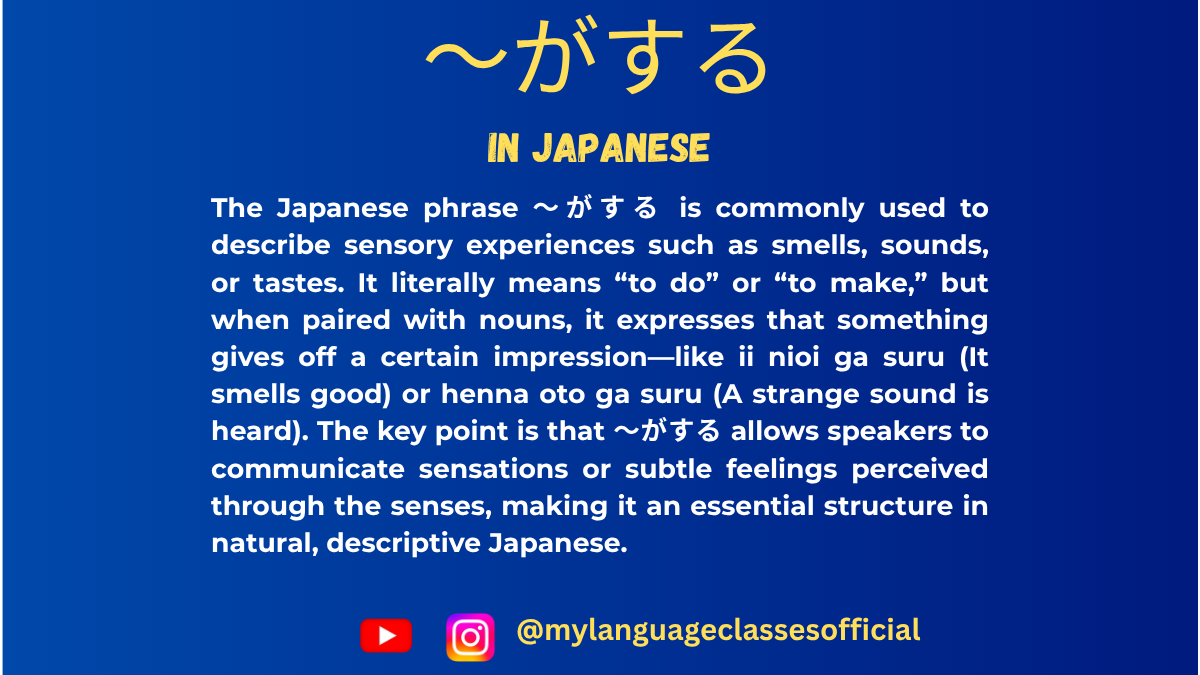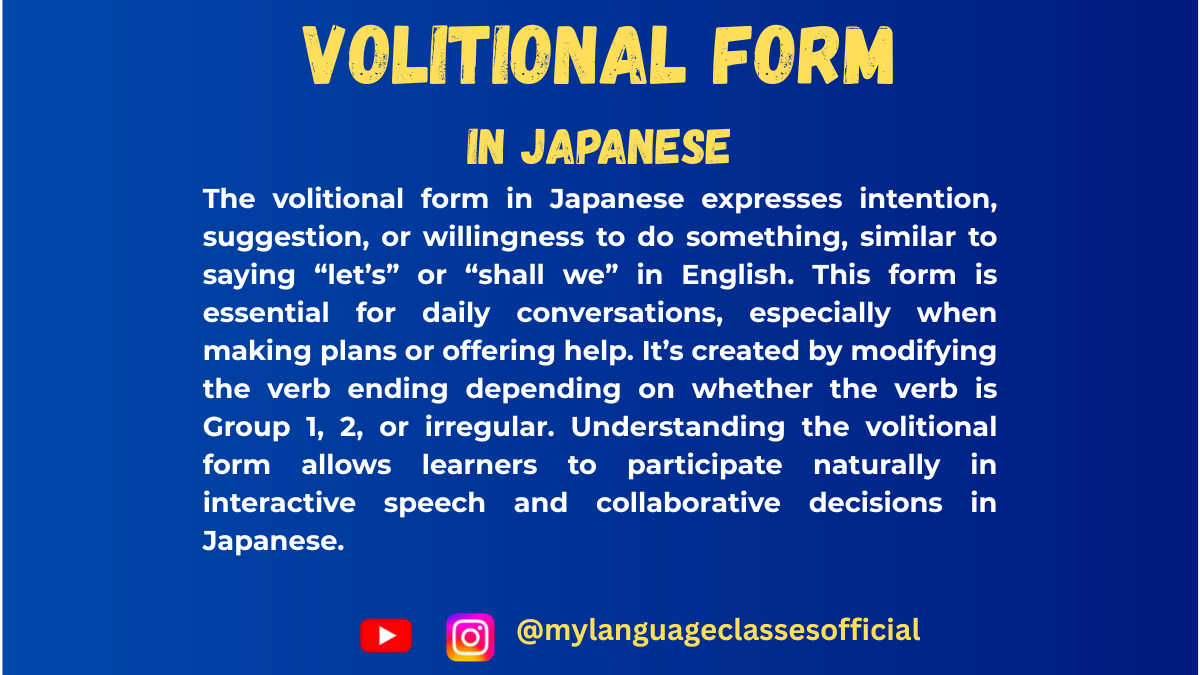Your cart is currently empty!
Tag: consciousness
-

Understanding 〜がする in Japanese | My Language Classes
Understanding the Usage of 〜がする in Japanese
The expression 〜がする is a common grammatical structure in Japanese used to describe perceptions and sensations related to the five senses, as well as intuitive feelings. It is often translated as “to smell,” “to taste,” “to feel,” or “to sound like.” This phrase allows the speaker to express their sensory or emotional experience in a natural way.
Basic Structure of 〜がする
The pattern generally follows this structure:
[Noun] + がする
Here, [Noun] represents something perceived through the senses (such as smell, taste, sound, or feeling). The verb する indicates that the sensation exists.
Situations Where 〜がする is Used
Below are the different contexts where 〜がする is commonly used:
1. Smell (Odor-related Perception)
Used when describing a smell that one perceives.
- 変なにおいがする。 (Henna nioi ga suru.) – “There is a strange smell.”
- 花の香りがする。 (Hana no kaori ga suru.) – “I smell the fragrance of flowers.”
- ガスのにおいがする。 (Gasu no nioi ga suru.) – “It smells like gas.”
2. Taste (Flavor-related Perception)
Used when describing the taste of something.
- 変な味がする。 (Henna aji ga suru.) – “It has a strange taste.”
- この水は鉄の味がする。 (Kono mizu wa tetsu no aji ga suru.) – “This water tastes like iron.”
- 甘い味がする。 (Amai aji ga suru.) – “It tastes sweet.”
3. Sound (Auditory Perception)
Used when describing a sound that one hears.
- ドアの開く音がする。 (Doa no hiraku oto ga suru.) – “I hear the sound of a door opening.”
- 雷の音がする。 (Kaminari no oto ga suru.) – “I hear the sound of thunder.”
- 人の話し声がする。 (Hito no hanashigoe ga suru.) – “I hear people’s voices.”
4. Feeling (Emotional or Intuitive Perception)
Used when describing a feeling, intuition, or an atmosphere.
- 嫌な感じがする。 (Iyana kanji ga suru.) – “I have a bad feeling.”
- 胸騒ぎがする。 (Munasawagi ga suru.) – “I have a premonition (of something bad).”
- ワクワクする感じがする。 (Wakuwaku suru kanji ga suru.) – “I have an exciting feeling.”
5. Physical Sensations (Pain or Bodily Feelings)
Used when describing physical sensations or discomfort.
- 頭が痛い感じがする。 (Atama ga itai kanji ga suru.) – “I feel like I have a headache.”
- 吐き気がする。 (Hakike ga suru.) – “I feel nauseous.”
- 寒気がする。 (Samuke ga suru.) – “I feel chills.”
6. Other Abstract Feelings and Situations
It can be used to describe abstract or indirect experiences.
- あの人は信用できない気がする。 (Ano hito wa shinyou dekinai ki ga suru.) – “I feel like that person is untrustworthy.”
- ここは何か違う感じがする。 (Koko wa nanika chigau kanji ga suru.) – “This place feels different.”
Key Points to Remember
- 〜がする is used to describe sensory experiences, including smell, taste, sound, and physical or emotional feelings.
- It is typically used with nouns related to perception, such as におい (smell), 味 (taste), 音 (sound), 気 (feeling), 感じ (sensation), 痛み (pain), etc.
- It can be used for both literal (real sensory perceptions) and abstract (intuition, atmosphere, emotions) experiences.
- The phrase makes statements subjective, meaning it expresses the speaker’s personal perception rather than an objective fact.
Conclusion
Understanding 〜がする is essential for expressing sensory perceptions naturally in Japanese. Whether you’re describing a delicious meal, a strange smell, an ominous feeling, or an unexpected noise, this structure is an invaluable tool in communication. Mastering its usage will enhance your ability to express experiences vividly and naturally in Japanese.
By practicing various sentence patterns using 〜がする, learners can deepen their understanding and fluency in Japanese conversation. Try using it in your daily observations to get more comfortable with its application!
If you enjoyed this lesson, be sure to check out more posts like this on my blog at My Language Classes. Don’t forget to subscribe my YouTube channel and follow me on Instagram for the latest language learning tips and lessons. Leave a comment below to share your thoughts, or ask any questions you have about nouns.
Happy learning! 😊
-

Understanding Volitional Form in Japanese | My Language Classes
Volitional Form in Japanese
The volitional form in Japanese is a versatile and essential grammatical structure. It’s often used to express intentions, suggestions, or invitations. Think of it as the Japanese equivalent of saying, “Let’s” or “Shall we?” in English.
This post will break it down into two main categories: the informal volitional form and the polite volitional form, making it easy for learners of all levels to grasp and apply.
1. The Informal Volitional Form
The informal volitional form is used casually among friends, family, or people you’re close to. It’s the shorter, more relaxed version of suggesting something.
How to Form It
The structure depends on whether the verb is a う-verb or a る-verb. Here’s how you can form the volitional form:
- For う-verbs: Replace the final う sound with おう.
- Example:
- 行く (iku – to go) → 行こう (ikou – Let’s go)
- 飲む (nomu – to drink) → 飲もう (nomou – Let’s drink)
- Example:
- For る-verbs: Drop the る and add よう.
- Example:
- 食べる (taberu – to eat) → 食べよう (tabeyou – Let’s eat)
- 見る (miru – to see/watch) → 見よう (miyou – Let’s watch)
- Example:
- Irregular verbs: These don’t follow the usual patterns and need to be memorized:
- する (suru – to do) → しよう (shiyou – Let’s do)
- 来る (kuru – to come) → 来よう (koyou – Let’s come)
When to Use It
Use the informal volitional form in casual contexts:
- Planning something with friends:
- 映画を見よう! (Eiga o miyou! – Let’s watch a movie!)
- Deciding something for yourself:
- もっと頑張ろう。 (Motto ganbarou. – I’ll try harder.)
2. The Polite Volitional Form
For more formal situations, the polite volitional form is used. This is especially common in workplaces, public settings, or when speaking to superiors or strangers.
How to Form It
The polite volitional form follows a straightforward rule:
- Take the stem of the verb and add ましょう.
- Example:
- 行く (iku – to go) → 行きましょう (ikimashou – Let’s go)
- 食べる (taberu – to eat) → 食べましょう (tabemashou – Let’s eat)
When to Use It
Use the polite volitional form in formal or respectful contexts:
- Inviting someone politely:
- 一緒に昼ご飯を食べましょうか? (Issho ni hiru gohan o tabemashou ka? – Shall we have lunch together?)
- Offering a suggestion in a business setting:
- 次のステップを考えましょう。 (Tsugi no suteppu o kangaemashou. – Let’s think about the next step.)
3. Key Differences Between Informal and Polite Forms
Aspect Informal Volitional Form Polite Volitional Form Tone Casual Formal/Respectful Ending おう/よう Verb stem + ましょう Usage Context Friends, family Business, public, formal
4. Practice Makes Perfect!
Here are a few sentences to test your understanding. Try converting them into both informal and polite volitional forms:
- 泳ぐ (oyogu – to swim)
- 話す (hanasu – to talk)
- 勉強する (benkyou suru – to study)
Answers:
- 泳ぐ: 泳ごう / 泳ぎましょう
- 話す: 話そう / 話しましょう
- 勉強する: 勉強しよう / 勉強しましょう
By mastering the volitional form, you’ll be well on your way to expressing intentions and making suggestions naturally in Japanese. Practice using these forms in conversations, and soon they’ll become second nature. 頑張りましょう! (Ganbarimashou! – Let’s do our best!)
If you enjoyed this lesson, be sure to check out more posts like this on my blog at My Language Classes. Don’t forget to subscribe my YouTube channel and follow me on Instagram for the latest language learning tips and lessons. Leave a comment below to share your thoughts, or ask any questions you have about nouns.
Happy learning! 😊
- For う-verbs: Replace the final う sound with おう.
